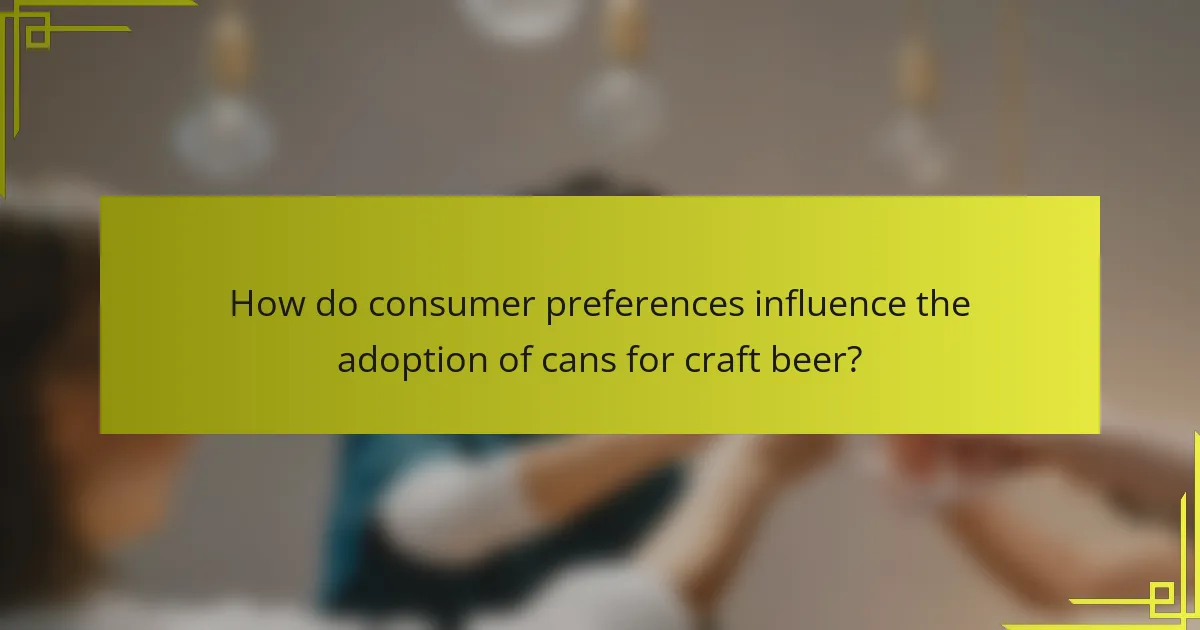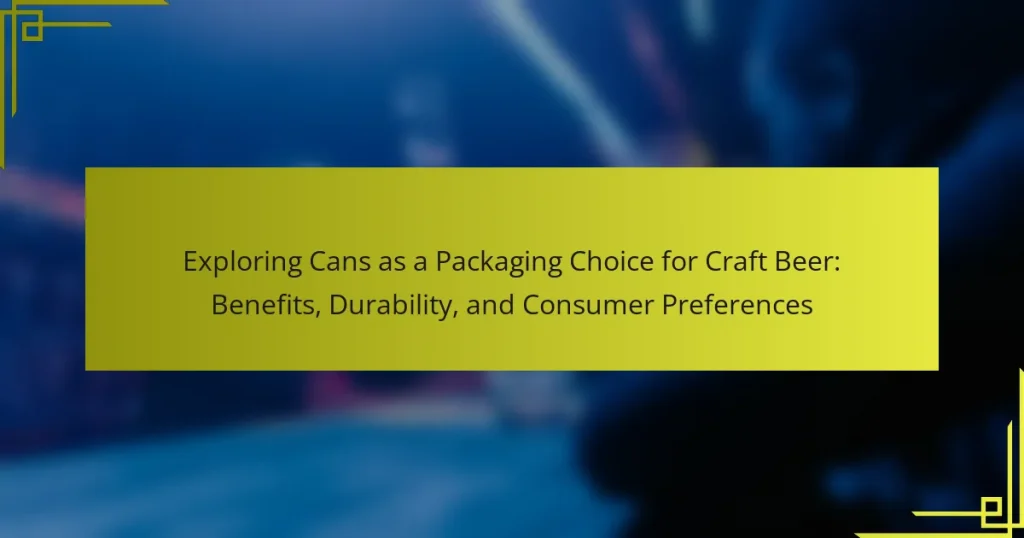Cans are increasingly recognized as a preferred packaging choice for craft beer due to their numerous advantages. They are lightweight, portable, and provide superior protection against light and oxygen, which can spoil beer and affect its flavor. Cans are also more environmentally friendly, as they are recycled at higher rates than glass bottles, and they chill faster, enhancing the drinking experience. The durability of cans ensures that the beer remains protected during transportation, preventing damage and preserving quality. Additionally, consumer preferences play a significant role in the adoption of cans, with many drinkers favoring their convenience and unique branding opportunities. This article explores the benefits of cans, their durability, and the influence of consumer preferences on craft beer packaging choices.

What are the advantages of using cans for craft beer packaging?
Cans offer several advantages for craft beer packaging. They are lightweight and more portable than bottles. Cans provide better protection against light and oxygen, both of which can spoil beer. This helps maintain the beer’s flavor and freshness longer. Additionally, cans are more environmentally friendly due to their recyclability. Studies show that aluminum cans are recycled at a higher rate than glass bottles. Cans also chill faster, enhancing the drinking experience. Furthermore, they allow for more creative labeling and branding opportunities. These factors make cans a preferred choice among craft brewers and consumers alike.
How do cans compare to bottles in terms of protection and preservation?
Cans provide superior protection and preservation compared to bottles. Cans are airtight, preventing oxygen exposure, which can degrade beer quality. They also block light, which can cause skunking in beer. Bottles, especially clear and green ones, allow light [censured]. This light exposure can negatively impact the flavor profile of the beer. Additionally, cans are less prone to breakage than glass bottles. The durability of cans makes them more suitable for transport and storage. Research indicates that beer stored in cans maintains its freshness longer than beer in bottles. Overall, cans offer better protection and preservation for craft beer.
What factors contribute to the protective qualities of cans?
Cans provide protective qualities primarily due to their material and design. Aluminum and steel are the common materials used, which are both strong and lightweight. These metals offer excellent resistance to physical damage, preventing breakage during handling and transport. Cans also block light and oxygen, which helps preserve the quality of the contents, particularly for craft beer. The hermetic seal of a can prevents contamination and spoilage, ensuring freshness. Additionally, the cylindrical shape of cans distributes pressure evenly, reducing the risk of deformation. This structural integrity is crucial during storage and transportation, maintaining the can’s protective capabilities.
How do cans affect the flavor and freshness of craft beer?
Cans preserve the flavor and freshness of craft beer effectively. They provide a complete seal that prevents oxygen exposure. Oxygen can lead to oxidation, which negatively impacts taste. Cans also block light, protecting beer from light exposure. Light can cause skunking, which alters flavor. Studies show that canned beer maintains its quality longer than bottled beer. A 2018 survey indicated that 75% of craft brewers prefer cans for these reasons. Cans are lightweight and recyclable, making them convenient for consumers. Overall, cans enhance the longevity and quality of craft beer.
What environmental benefits do cans offer for craft beer packaging?
Cans offer significant environmental benefits for craft beer packaging. They are recyclable and can be processed indefinitely without loss of quality. Approximately 75% of aluminum cans are recycled in the United States. This reduces the need for new raw materials and energy consumption. Cans also have a lower carbon footprint compared to glass bottles. The lightweight nature of cans leads to reduced transportation emissions. Additionally, cans protect beer from light and oxygen, minimizing spoilage and waste. Overall, using cans promotes sustainability in the craft beer industry.
How does the recyclability of cans impact sustainability?
The recyclability of cans significantly enhances sustainability. Cans are made from aluminum and steel, materials that can be recycled indefinitely without losing quality. Recycling cans reduces the need for raw materials, conserving natural resources. It also saves energy; recycling aluminum uses 95% less energy than producing new aluminum. In 2020, the recycling rate for aluminum cans in the U.S. was about 50%, according to the Aluminum Association. Higher recycling rates lead to lower greenhouse gas emissions, contributing to climate change mitigation. Therefore, the recyclability of cans plays a crucial role in promoting environmental sustainability.
What are the energy savings associated with can production and recycling?
Recycling aluminum cans saves 95% of the energy required to produce new cans from raw materials. Producing new aluminum from bauxite ore is energy-intensive. It requires about 20 times more energy than recycling existing aluminum. In 2020, the recycling rate for aluminum cans in the U.S. was approximately 50%. This means a significant amount of energy is conserved through recycling efforts. Additionally, recycling one ton of aluminum can save around 14,000 kWh of electricity. This energy savings translates into reduced greenhouse gas emissions and lower overall environmental impact.

What role does durability play in the choice of cans for craft beer?
Durability is crucial in the choice of cans for craft beer. It ensures that the beer remains protected from external elements. Durable cans prevent light and oxygen exposure, which can spoil the beer. They also resist physical damage during transportation and handling. This protection helps maintain the beer’s flavor and quality. According to the Brewers Association, cans are less likely to break than glass bottles. This reduces waste and enhances consumer convenience. Overall, durability directly impacts product integrity and consumer satisfaction.
How do cans withstand transportation and storage challenges?
Cans withstand transportation and storage challenges due to their structural integrity and material properties. The aluminum or steel used in cans provides high strength-to-weight ratios. This design minimizes the risk of damage during handling and transport. Cans are also sealed tightly, preventing contamination and preserving contents.
The cylindrical shape distributes pressure evenly, reducing the likelihood of deformation. Additionally, cans are stackable, optimizing space during storage and transport. Studies show that cans can endure impacts and vibrations better than glass bottles. This resilience contributes to lower breakage rates and ensures product safety.
What materials are used in can manufacturing to enhance durability?
Aluminum and steel are the primary materials used in can manufacturing to enhance durability. Aluminum is lightweight and resistant to corrosion. It provides excellent protection against light and oxygen, which helps preserve the contents. Steel, often used for larger containers, offers high strength and rigidity. Both materials can be treated with coatings to prevent rust and enhance longevity. The use of these materials ensures that cans can withstand pressure and impact during transport and storage.
How does the design of cans contribute to their strength?
The design of cans contributes to their strength through structural features and material properties. Cans are typically made from aluminum or steel, which are lightweight yet strong materials. The cylindrical shape of cans distributes internal pressure evenly, enhancing resistance to deformation. Additionally, the can’s end closures are designed to create a hermetic seal, preventing leaks and maintaining structural integrity. Ribbing or indentations may also be incorporated to increase strength without adding significant weight. These design elements ensure that cans can withstand stacking, handling, and transportation stresses effectively.
What are the potential drawbacks of using cans for craft beer?
Cans for craft beer have several potential drawbacks. One major issue is the perception of taste. Some consumers believe that beer in cans has an off-flavor compared to bottles. This perception can affect sales and brand reputation. Another drawback is the limited availability of certain styles. Some craft breweries may not can all their offerings, focusing instead on bottles or draft. Additionally, cans can be less environmentally friendly if not recycled properly. While aluminum is recyclable, improper disposal can lead to environmental harm. Lastly, there is a risk of light exposure if cans are not properly lined. Light can spoil the beer, leading to undesirable flavors. These factors contribute to hesitance among consumers regarding canned craft beer.
Are there any limitations associated with canning craft beer?
Yes, there are limitations associated with canning craft beer. One limitation is the initial investment required for canning equipment. Canning lines can be expensive, which may be a barrier for small breweries. Another limitation is the potential for oxidation. If cans are not properly sealed, oxygen can enter and spoil the beer. Additionally, some craft beers may not be suitable for canning due to their specific flavor profiles. Certain styles, such as barrel-aged beers, may lose their character when canned. Lastly, there is a perception among some consumers that canned beer is of lower quality compared to bottled beer. This perception can affect market acceptance.
How do consumers perceive the quality of beer in cans compared to bottles?
Consumers generally perceive beer in bottles as higher quality compared to beer in cans. This perception is often influenced by traditional views and marketing. Many consumers associate bottles with craft and premium beers. Studies indicate that packaging can affect taste expectations and overall enjoyment. Research by the Brewers Association shows that 70% of craft beer drinkers prefer bottles. However, perceptions are changing as cans gain popularity for their convenience and portability. Some consumers recognize that cans protect beer from light and oxygen, which can spoil flavor. Overall, while bottles maintain a quality perception, cans are increasingly accepted in the market.

How do consumer preferences influence the adoption of cans for craft beer?
Consumer preferences significantly influence the adoption of cans for craft beer. Many consumers prefer cans due to their portability and convenience. Cans are lighter and easier to transport than bottles. Additionally, cans protect beer from light exposure, preserving flavor. Research indicates that 70% of craft beer drinkers favor cans for these reasons. The aesthetic appeal of can designs also attracts consumers. Unique artwork on cans can enhance brand recognition. Therefore, consumer preferences directly drive breweries to adopt can packaging.
What factors do consumers consider when choosing between cans and bottles?
Consumers consider several factors when choosing between cans and bottles for beverages. These factors include taste preservation, convenience, environmental impact, and packaging durability. Cans are often perceived to protect the beverage from light and oxygen, which can affect flavor. Bottles are seen as a premium option, often associated with higher quality. Convenience plays a role, as cans are lighter and more portable than bottles. Environmental considerations are also significant; cans are typically more recyclable and have a lower carbon footprint in transportation. Additionally, the aesthetic appeal of packaging can influence consumer preferences. Studies indicate that packaging design can affect purchasing decisions significantly.
How does convenience play a role in consumer choices?
Convenience significantly influences consumer choices by prioritizing ease of access and use. Consumers often prefer products that require minimal effort to obtain and utilize. For example, packaging that is lightweight and portable, such as cans for craft beer, enhances convenience. Research indicates that 74% of consumers consider convenience a key factor in their purchasing decisions. Additionally, easy-to-open packaging can lead to higher satisfaction and repeat purchases. This preference for convenience drives brands to adopt packaging solutions that align with consumer lifestyles.
What impact does branding and design have on consumer preferences?
Branding and design significantly influence consumer preferences. Effective branding creates recognition and trust. Consumers often associate strong brands with quality. Design elements, such as color and typography, impact emotional responses. Research shows that 93% of consumers base their purchasing decisions on visual appearance. Additionally, unique packaging design can differentiate products in a crowded market. For example, craft beer brands use distinctive can designs to attract attention. This strategy enhances the likelihood of trial and repeat purchases. Overall, branding and design play crucial roles in shaping consumer choices.
What trends are emerging in consumer preferences for craft beer packaging?
Consumers increasingly prefer sustainable packaging for craft beer. This trend reflects a growing awareness of environmental issues. Many craft breweries are adopting recyclable cans over glass bottles. Cans are lighter, reducing transportation emissions. They also offer better protection against light and oxygen, preserving beer quality. Additionally, consumers appreciate the convenience of cans for outdoor activities. The rise of bold and artistic can designs appeals to younger demographics. Research indicates that 70% of craft beer drinkers consider packaging when making purchase decisions.
How are craft breweries adapting to changing consumer demands for packaging?
Craft breweries are adapting to changing consumer demands for packaging by increasingly utilizing cans instead of bottles. Cans offer superior protection against light and oxygen, preserving the beer’s flavor. Additionally, they are lighter and more portable, appealing to consumers who prioritize convenience. Many craft breweries are also embracing eco-friendly packaging options, such as recyclable materials. This shift aligns with consumer preferences for sustainability and environmental responsibility. According to a 2022 industry report, 70% of craft beer consumers prefer canned products due to these benefits. As a result, craft breweries are investing in canning technology and design to meet these evolving demands.
What innovations are being explored in can design and functionality?
Innovations in can design and functionality include improved materials and ergonomic shapes. Lightweight aluminum is increasingly used to reduce environmental impact. Some designs incorporate resealable tops for convenience. Others feature integrated straws for easier consumption. Smart technology is being explored for tracking freshness through QR codes. Enhanced printing techniques allow for vibrant, eye-catching graphics. These innovations aim to enhance user experience and sustainability. Research indicates that consumers prefer cans with functional designs that offer added value.
What best practices should craft breweries follow when choosing cans for packaging?
Craft breweries should prioritize selecting aluminum cans that are lightweight and recyclable. Cans should have a proper lining to prevent beer from reacting with the metal. A standard can size, such as 12 oz or 16 oz, is often preferred for market consistency. Breweries should also consider using cans with UV protection to preserve beer quality. Custom designs can enhance brand visibility and consumer appeal. Choosing a reputable supplier ensures reliability in quality and delivery. Cans should be tested for sealing integrity to prevent leaks. Finally, breweries should evaluate the environmental impact of their packaging choices to align with consumer preferences for sustainability.
The main entity of the article is cans as a packaging choice for craft beer. The article explores the advantages of using cans, including their lightweight nature, superior protection against light and oxygen, and environmental benefits due to higher recyclability rates. It compares cans to bottles in terms of preservation and durability, highlighting how cans help maintain flavor and freshness. Additionally, the article discusses consumer preferences, trends in packaging, and best practices for craft breweries when selecting can packaging. Overall, it provides a comprehensive overview of the benefits and considerations associated with using cans for craft beer.




